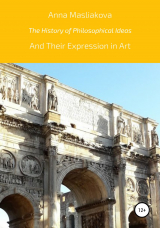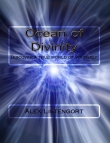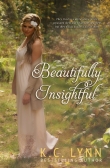
Текст книги "The History of Philosophical Ideas and Their Expression in Art"
Автор книги: Анна Маслякова
Жанр:
Искусство и Дизайн
сообщить о нарушении
Текущая страница: 2 (всего у книги 3 страниц)
Dialog of Arts I
The Greco-Roman civilization extended from the glorious Age of Pericles when Greek Culture reached its height, witnessed the expansion of Greek settlements under Alexander the Great, saw the Rise of Roman Power and the grandeur of the Roman Empire and concluded with its decline and fall in 476.
Greek and Roman traditions are completely different, suffice it to mention the Venus of Tauris and Roman Portrait Sculpture executed in realistic manner. The Greeks with their city-states, meetings at Agora, philosophical discussions at the Platonic Academy and Classical Orders have been considered as an example for many generations. The Romans adopted their ideas (for instance, they used to gather at the Forum located at the intersection of the two main roads – Cardo and Decumanus), and yet, they were more interested in technical developments and built a lot of roads and aqueducts bringing water into cities and towns (Devil’s Bridge at Tarragona). Eugène Viollet-le-Duc in his “Lectures on Architecture” says that “The genius of the Roman people differs materially from that of the Greeks. The Roman is essentially an administrator and a politician; he is the founder of the Modern Civilization: but is he, like the Greek, an Artist? Certainly not”. The Romans erected temples on artificial hills made of concrete, whereas the Greeks were fond of Nature and tried to find special places for their structures (the Temple of Segesta in Sicily). Moreover, columns were no longer used as constructive elements and became purely decorative (The Colosseum). “Greek architecture may be best compared to a man strip of his clothes, the external parts of whose body are but the consequence of his organic structure, of his wants, of the framework of his bones, and the functions of his muscles. The man is so much the more beautiful as all the parts of his body are in harmony with their purpose, and, with nothing superfluous, they yet suffice for their functions. Roman architecture, on the other hand, may be compared to a man clothed: there is the man, and there is the dress; the dress may be good or bad, rich or poor in material, well or ill cut, but it forms no part of the body”.
The Greeks and the Romans were not satisfied with white color, on the contrary they used to paint their sculpture and architecture so as to accentuate their Beauty. Viollet-le-Duc writes that “So necessary was this application of color to the exterior of the buildings in a country where the atmosphere is of marvelous transparency, that if we view the Temple of Theseus at Athens (for instance) in full sunshine, now that it has lost its paintings, we shall find it impossible to distinguish the lights of the columns from those shed of the walls of the cellar; – these lights on different planes mingle together and appear as if thrown upon one single surface”.
Life and thought in those days were bound up with the Arts and the Greeks were very well-rounded people. The great Philosophers were men of action who serve Athens at battlefields as well as in public places and Theaters since one of the main responsibilities of a citizen was to foster the Arts. Art in Greece became a generating force by which the Athenians identified themselves with their fellow-citizens and with the entire rhythm of life around them. And through Art human experience has been raised to its highest level. Not only did they use Music in their system of Public Education, but they also incorporated it in their incredible Dramas and Tragedies (let us mention, for example, “Oedipus Rex” by Sophocles – one of the most successful playwrights of the time). Aristotle in his “Poetics” says that “Be that as it may, Tragedy – as also Comedy – was at first mere improvisation. The one originated with the authors of the Dithyramb, the other with those of the phallic songs, which are still in use in many of our cities. Tragedy advanced by slow degrees; each new element that showed itself was in turn developed. Having passed through many changes, it found its natural form, and there it stopped”. “Comedy is, as we have said, an imitation of characters of a lower type, not, however, in the full sense of the word bad, the Ludicrous being merely a subdivision of the ugly. It consists in some defect or ugliness which is not painful or destructive. To take an obvious example, the comic mask is ugly and distorted, but does not imply pain”.
Not only did they believe that Poetry and Music are the same, but they also had the Chorus that often put interesting commentaries on the drama and unified it. Friedrich Nietzsche writes that “If music, as it would seem, was previously known as an Apollonian art, it was, strictly speaking, only as the wave-beat of rhythm, the formative power of which was developed to the representation of Apollonian conditions. The music of Apollo was Doric architectonics in tones, but in merely suggested tones, such as those of the cithara. The very element which forms the essence of Dionysian music (and hence of music in general) is carefully excluded as un-Apollonian; namely, the thrilling power of the tone, the uniform stream of the melos, and the thoroughly incomparable world of harmony”. “According to this view, we must understand Greek tragedy as the Dionysian chorus, which always disburdens itself anew in an Apollonian world of pictures. The choric parts, therefore, with which tragedy is interlaced, are in a manner the mother-womb of the entire so-called dialogue, that is, of the whole stage-world, of the drama proper. In several successive outbursts does this primordial basis of tragedy beam forth the vision of the drama, which is a dream-phenomenon throughout, and, as such, epic in character: on the other hand, however, as objectivation of a Dionysian state, it does not represent the Apollonian redemption in appearance, but, conversely, the dissolution of the individual and his unification with primordial existence. Accordingly, the drama is the Apollonian embodiment of Dionysian perceptions and influences, and is thereby separated from the epic as by an immense gap. The chorus of Greek tragedy, the symbol of the mass of the people moved by Dionysian excitement, is thus fully explained by our conception of it as here set forth” (“The Birth of Tragedy”).
As we have mentioned before, the Romans adopted Greek inventions and developed them on a much larger scale. In Ancient Roman Villas – country houses of nobility rectangular in their shape – they combined Perystilium (a garden surrounded by columns reminding of the Medieval Cloister) and Atrium (the most important part where the guests were greeted) complemented by Compluvium (a square roof opening) and Impluvium (a pool for rainwater). Villas in Pompeii were richly decorated with frescoes of different styles – creating the illusion of marble or panoramic view (like “a window”), emphasizing the flatness of the wall with figures “floating” on it or reintroducing architecture and jumbling together fragments of buildings – and all of them can be seen at the House of Vettii.
And yet, there was a tendency in Roman Philosophy towards individualism and agnosticism (Stoicism, Epicureanism, Skepticism). People were more interested in entertainments, such as Gladiatorial Fights, execution of Christians at the Colosseum and Nero’s singing. It is said that Nero ordered to burn Rome in order to clear the space for his new palace – Domus Aurea designed by Fabulus. It was embellished with gold and decorated with Grotesques which inspired Raphael to create his Loggias in Vatican (and we also have their copies at the Hermitage Museum in Saint Petersburg). After the Emperor’s death the Golden House was filled with earth and built over (Flavian Amphitheater, Baths of Trajan, etc.). By the way, the plan of the Trajan’s Forum reminds of the embracing arms of the Bernini Colonnade, while the structure of Caldarium – a special room with hot water pool at the Roman Baths which had a dome with an opening or oculus – calls to mind the Octagonal Room in the Domus Aurea and the Pantheon. Surprisingly enough, there even was an Ancient Roman Baroque Style, in other words, architects used traditional vocabulary in a different way including too ornate decoration, projections, recessions and broken pediments in their projects (for example, the Market Gate of Miletus in Berlin).
Homer is considered to be the father of Western Civilization and Vergil’s “Aeneid” as an epic traces the general form of “The Iliad” (which tells us about Achilles who managed to overcome his rage and returned Hector’s body to this father Priam) and “The Odyssey” (in which the main hero Odysseus is going back home after the Fall of Troy and experiencing different kinds of hospitality – Cyclopes, Nausicaa, Dionysian Music performed by Sirens, etc.) but in the reverse order. That is to say, the wanderings of Aeneas and his people come first (“Odyssey”) and then the war starts (“Iliad”). J.L. Borges in one of his lectures at Harvard said that “The Geeks had no use for books or no great use for them, it is a fact indeed that most of the great teachers of mankind have been not writers but speakers”. “However, we need not worry too much about the fate of the Classics because Beauty is always with us”. Suffice it to mention the Mysterious smile of Ancient Kore.
Temples of Culture I
The most extraordinary thing about Ancient Greek architecture is their idea about the Sight, that is to say, the organization of space is based on special viewpoints. Here were are in the Theatre of Delphi looking down and all the buildings arrange themselves in such a way as to be viewed obliquely as fully plastic objects.
Basically, the Greek Theater (the Theater at Epidaurus, the Ancient Theater in Tauric Chersonesus, etc.) is an open-air structure composed of a partial circle (Theatron) organized around the Orchestra where action takes place and a backstage (Skene) behind it. And one of the most powerful things is that like in the case of temples – for example, the Temple of Segesta in Sicily – they find a special place that needs to be clarified and make visible its uniqueness that otherwise would be lost.
The Romans, on the contrary, prefer free standing structures frontally oriented and densely packed into a city. Let us have a look, for instance, at the Theater of Marcellus in Rome. Typologically, it conserves quite a lot from the Greeks, but the architectural edge closes the space off. Moreover, the Flavian Amphitheater – a giant object in the city of Rome – consists of two semicircles merged together and is by no means open-ended. Another allusion to the Greek architecture is that the décor of the Colosseum combines different orders – Doric, Ionic, Corinthian – and yet, the columns are not free standing (the Parthenon in Athens) but they are engaged in the walls (like in the Maison Carrée in Nimes).
The Romans were abscessed with technology and that allowed them to build in a very different way. The arch became the fundamental element of Roman architecture enabling them to erect bridges (The Alcántara Bridge), aqueducts (Devil’s bridge in Tarragona) and even the Pantheon – a temple to all the gods with a lot of altars.
The Romans were more interested in entertainment than in dramatic performances. And yet, the situation has been changing and not long ago they have started to organize concerts at the Colosseum, such as “The Three Tenors” in 1994.
How to Understand a Work of Art? Step I
There are places and works of Art that could change your life right away.
“The Ecstasy of Saint Teresa” by Gian Lorenzo Bernini located at Santa Maria della Vittoria in Rome. It was a rainy day and when I entered the church there it was – glowing in the dark, Mysterious and unreal.
“The Moses” by Michelangelo Buonarroti at San Pietro in Vincoli which differs greatly from the other sculptures decorating the Tomb of Pope Julius II. I came to the church early in the morning and there was nobody inside it but me.
Michelangelo’s “Pieta” which I noticed during my second visit to Saint Peter’s Basilica. By the way, despite the fact that it is located rather far from the isle and you need a very good camera to take a photo, the sculpture is absolutely amazing.
Argentine Tango full of passion and sensuality also will not leave you unchanged.
Nevertheless, from time to time it could be helpful to make an effort and use our imagination in order to find out how monuments of the past might have looked like in those days when Roman Culture reached its height.
On the one hand, during my first visit to Santa Maria Maggiore, the interiors of which are richly adorned with mosaics in Byzantine style, I tried to “deconstruct” it, metaphorically speaking, so as to appreciate the Beauty of the original church.
On the other hand, while wandering around the Roman Forum, the place where people used to gather and discuss important issues, I had to “reconstruct” half-destroyed or even missing buildings.
To sum it up, on the whole, there is a variety of possibilities for those who are determined to succeed in studying Art. And if one of the methods mentioned above do not appeals to you, you should try another one.
To be continued…
Chapter II
Once Upon a Time
I decided to go from Minsk to Vilnius. Surprisingly, it turned out that it was not a tourist trip as I had expected, but a pilgrimage tour.
Firstly, when I passed through the Sharp Gate or Ostra Brama and entered the old part of the city, it dawned on me that there are a lot of churches in Vilnius. Suffice it to say that while walking from the Gate to the Vilnia River I visited Roman Catholic Church of St. Teresa in Baroque style, Orthodox Church of St. Nicholas in Neo-Byzantine style, Roman Catholic Church of St. Anna in Flamboyant Gothic and Brick Gothic styles and even Choral Synagogue in Moorish style, etc.
Moreover, there is a marvelous Roman Catholic Church of St. Peter and St. Paul on the other bank of the Vilnia River. Built in Baroque style, the church is richly decorated with sculptures and stucco reliefs inside and outside and thus it looks like a gorgeous porcelain casket. Needless to say, it completely took my breath away.
Secondly, despite the fact that the Memorial Museum of Mikalojus Konstantinas Čiurlionis is a little off the beaten track, it is definitely worth visiting. To cut a long story short, Čiurlionis’ Mysterious Paintings complemented by his Music which was being performed at the Museum made a strong impression on me.
Finally, when I returned to Minsk, I saw everything in a different light. Pardon me for mentioning it, but in spite of the fact that I had been studying in Minsk for about six years, I had never been in most of its churches until then. Wandering around the Church of Saints Simon and Helena, I realized that it bears striking resemblance to the Church of St. Anna in Vilnius. Furthermore, one day my friend took me to the Cathedral of St. Peter and St. Paul and showed the place where the choir is standing during the service. I will never forget how enchanting it was.
To sum it up, it seems to me that nothing happens accidentally; on the contrary, everything has its purpose. All you need to do is believe in yourself and you will live happily ever after, I presume.
Literary Essay II
Now when most parts of the world are on lockdown because of the virus and I have to work from home, my flat reminds me of Monastic Cell and I imagine myself being a Medieval Scholar who describes historical events and ponders the future.
As we all know, religious issues were of utmost importance in those days. Suffice it to mention “The Confessions” of Saint Augustine in which he is examining his own life, talking about his yearning for truth and his struggle with worldly desires, discussing the nature of sin and telling us about his conversion to Christianity.
At the same time, Chivalric Romances describing adventures of knight-errant and praising Courtly Love for idealized lady were extremely popular in the Middle Ages. For instance, “Lancelot, the Knight of the Cart” by Chrétien de Troyes or “Roman de la Rose” two parts of which were written by Guillaume de Lorris and Jean de Meun respectively. When I had seen highly detailed miniature from illuminated manuscript depicting the Lover entering the walled garden in search of the Rose symbolizing his lady’s love, I was dazzled by its refined Beauty.
As for love, it is said that there were the so-called “Lovers of Teruel” who lived in the 13th century and died young since the farther of the bride-to-be was against their marriage and made his daughter marry another man. One can find their tombs in the Mausoleum of the Amantes in Teruel – a city in Aragon where, by the way, there are a lot of buildings designed in the Mudéjar style bearing traces of Islamic Art. Rumor has it that William Shakespeare may have been inspired by this story of forbidden love when writing “Romeo and Juliet”.
During the Carnival of Venice, which also dates back to the Middle Ages, people could do what they liked and wear what they wanted hiding their faces behind elaborate Masks so that nobody could find out their identity. After all, life is a dream and only death “organizes” it, gives it shape and meaning.
And yet, let us hope for the best and continue our “investigation” following the example of Franciscan friar William of Baskerville, the main character of Umberto Eco’s novel “The Name of the Rose”.
Philosophical Issues II
The importance of Neoplatonism is that it provided the philosophical framework that dominated Medieval thought until the 11th-12th centuries. And it continued to be a powerful instrument after the Reformation, during the Renaissance, the Enlightenment, etc. That is to say, it has been tremendously influential.
Firstly and most importantly, Neoplatonists thought of the Hierarchy of Being with Emanations from the One, the Divine Being, to Nous or Intelligence, Logos, then to the World Soul and, finally, to the Phenomenal World. Moreover, there was an upward movement, parallel to this downward Emanation, known as Epistrophê (conversion, turning back). And inasmuch as everything flows out from and returns to the One, this is the form of monism and pantheism.
To some extent there are also traces of the idea of the Divine Trinity in the Neoplatonic Cosmology. Plotinus says in “The Enneads” – “There exists a Principle which transcends Being; this is The One, whose nature we have sought to establish in so far as such matters lend themselves to proof. Upon The One follows immediately the Principle which is at once Being and the Intellectual-Principle. Third comes the Principle, Soul”. As for the problem of evil, according to Neoplatonism, there is no absolutely bad that has emanated from the One. Primary (natural) evil arises in the process of Emanation (certain levels are lower than the other), while secondary (moral) appears when people insert their affections on things below and follow their appetites rather than reason. In order to ascend to the Good, climb back up the ladder, one should start from contemplating nature so as to see the Order, unity and good in it then contemplate Form within one’s soul, proceed to the contemplation of Nous, the Cosmic Intelligence itself, the Form of all Forms and, finally, achieve the Ecstatic Reunion with the One. In this sense we should mention “The Ecstasy of Saint Teresa” by Gian Lorenzo Bernini.
As far as Beauty is concerned, their approach is quite similar. Plotinus writes that “Beauty addresses itself chiefly to sight; but there is a beauty for the hearing too, as in certain combinations of words and in all kinds of music, for melodies and cadences are beautiful; and minds that lift themselves above the realm of sense to a higher order are aware of beauty in the conduct of life, in actions, in character, in the pursuits of the intellect; and there is the beauty of the virtues”. “Let us, then, go back to the source, and indicate at once the Principle that bestows beauty on material things. Undoubtedly this Principle exists; it is something that is perceived at the first glance, something which the soul names as from an ancient knowledge and, recognizing, welcomes it, enters into unison with it. But let the soul fall in with the Ugly and at once it shrinks within itself, denies the thing, turns away from it, not accordant, resenting it”. “All shapelessness whose kind admits of pattern and form, as long as it remains outside of Reason and Idea, is ugly by that very isolation from the Divine-Thought. And this is the Absolute Ugly: an ugly thing is something that has not been entirely mastered by pattern, that is by Reason, the Matter not yielding at all points and in all respects to Ideal-Form. But where the Ideal-Form has entered, it has grouped and coordinated what from a diversity of parts was to become a unity: it has rallied confusion into co-operation: it has made the sum one harmonious coherence: for the Idea is a unity and what it moulds must come to unity as far as multiplicity may. And on what has thus been compacted to unity, Beauty enthrones itself, giving itself to the parts as to the sum: when it lights on some natural unity, a thing of like parts, then it gives itself to that whole”.
Ambrose, an Archbishop of Milan, introduced Saint Augustine to Neoplatonism and that provided the vehicle for his thinking his way beyond dualism towards a consistent Christian Theism. As we have mentioned before, the Greeks in various ways seem to say that we are ruled by Reason, while St. Augustine thinks that we are not ruled by what we know – we are ruled by what we Love. God illumines the human mind, sheds light on it so as to enable us to see the Form, the nature of things in the world of Particulars. He writes in his “Confessions” – “And what did it profit me, that all the books I could procure of the so-called liberal arts, I, the vile slave of vile affections, read by myself, and understood? And I delighted in them, but knew not whence came all, that therein was true or certain. For I had my back to the light, and my face to the things enlightened; whence my face, with which I discerned the things enlightened, itself was not enlightened”. The difference from Plato is that we do not grasp Forms in their transcendent status, whereas the difference from Aristotle is that we do not abstract Forms from our experience of Particulars.
The main lasting contribution of this early Medieval period is in defining and exploring philosophical issues having to do with the relationship between Religious Faith and Philosophical traditions of Antiquity. The basic distinction is between creation that Emanates from the very being of the Divine and Creation that have been brought into being out of nothing, ex nihilo. Thomas Aquinas, feeling that there is a potential in Aristotle’s “Metaphysics” for being compatible with Christianity, insists that God is not an essence, a form of all forms, but the source of existence. That is to say, it is not form or matter that courses existence (material signata), but God is giving the Actuality of existence to a combination of form and matter which otherwise would be pure potential (material prima).
Among the alternatives to Platonism one should also mention Nominalism and Conceptualism. What Nominalists are saying is that the classic kind of metaphysical explanation for the orderliness of nature and for cosmic justice that goes back to Anaxagoras’ Nous, Heraclitus’ Logos and the developing theory of forms is false. There are no real forms of transcendent or imminent sort, no abstract general ideas, no universal concepts and only Individuals exist (Roscellinus, William of Ockham). Conceptualists, on the contrary, insist that Universal Concepts exist within our minds and that we do think them separately from particulars (Peter Abelard).
There is a question as to whether or not we think of a Piece Art as an abstract object. It seems to me that Masterpieces of Art and Music cannot be viewed as a “collection of particulars” simply because one could compose a fugue according to the rules or press the keys correctly, and yet, the result could be rather disappointing. There must be some Form of Eternal Existence that “illuminates” artists, inspires them so that even their Particular “mistakes” contribute to the Beauty of their work.








